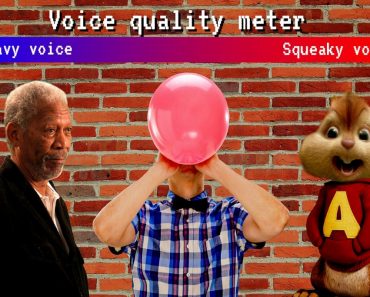Table of Contents (click to expand)
The element that causes some people to sing well and others to sing badly are problems with pitch accuracy, also known as intonation. Pitch can be understood as the ‘sharpness’ of a voice; the higher the pitch, the sharper and shriller the voice sounds.
Some people can sing. And other people belt Whitney Huston’s ‘And I will always love you!’ like a heartbroken banshee.
For the poor singers of the world, being able to hold the right note at the right time would be an achievement; a simple aspiration. What would it take for the poor singers of the world to get better at the skill? Can you learn the music or are some of us just doomed to wail like a banshee?

Recommended Video for you:
What Does It Take To Sing Well?
Of course, good singers are born with an amazing “instrument” that includes lungs with excellent vital capacity, exceptional breathing control, and a larynx that allows them to stretch and squeeze their vocal cords to achieve the desired vocal range. The shape and size of the pharynx and nasal cavities also correlate with its ability to sing. They have won the genetic lottery and can go on to become the Beyonces of the world. Most of us though have serviceable enough vocal cords for song singing.
Then, if you are a poor singer, you probably lack at least one of the following: timing and pitch.
These two metrics determine good music, singing included.
Timing is also called a beat. As the word suggests, it is like the clock of the music.
Broadly pitch is how we perceive the frequency of sound. Frequency is how long a song wave takes to complete one cycle. We perceive low frequencies as a low pitch. A low pitch sounds deep and bassier. A high frequency correlates to a high pitch which we call sharp and shrill sounds. We’ve given specific pitch names and arranged them in an order. The names of the pitches are called notes. For musicians who read sheet music, a note also indicates the duration to hold a pitch.
For non-offensive singing, it is enough to get the beat and pitch right. The brain is good at detecting these almost naturally. Most of us can detect something off with a song, just like sniffing spoilt food. When someone is off by a semitone (a measure between the interval of pitches), then that person is said to have poor pitch.
Professional and prodigious musicians are exceptional at discriminating between different pitches. Their brains, one might say, are wired to understand pitch. A small fraction of the population has perfect pitch. These people can identify the pitches exactly in any sound, from the clink of a glass to the grating of nails on a chalkboard. Jacob Collier and Charlie Puth frequently demonstrate their perfect pitch.
Poor Pitch Recognition And Imitation
The most egregious of errors is getting the pitch wrong.
3% of people in the world are amusics and they tend to be pitch deaf. They cannot discriminate between different pitches and struggle to reproduce the song. This is a minority, and studying amusics and the average singer shows us that most of us can identify pitch.
For the average singer, the problem can lie in one of two places.
First, you can’t recognize the pitch. A study has shown that, as humans, we can recognize different pitches and replicate them on an instrument, although it may be difficult for some of us to hear a pitch and recreate the sound with our voices, showing that we have the innate ability to “recognize” pitches. The average singer does not have a developed enough ear.
But, we tend to recognize pitch in songs since they have musical structure. This brings us to our second problem: imitating the pitch. In other words, the “input” component is fine; the problem occurs at the “output.”
After you hear the sound, the brain sets up an output sound corresponding to what you hear, but unfortunately, it is not in tune. Singing is moving the vocal folds to produce the pitch you want. It is a combination of muscle movement and airflow. The brain has a neural pathway that maps pitch into vocal movements. For those of us singing out of tune, our brains might just not know how to move muscles to create the right pitch.
Even when you do realize that you are singing off-key, there is not much you can do about it. Your ears do register that you’re not quite producing the tone that you intended to, so the vocal cords ask for instructions from the brain.
However, the brain still sends the same instructions, and you simply can’t get the tone right. It’s almost as though the vocal cords have locked themselves in a particular position to produce the same erroneous tone every time, even after knowing better!
You Can Improve Your Singing!
To improve your singing, practice it. Singing is just making the right muscle movements, a bit like dancing with your voice. With the right posture, breathing technique, and vocal control, you should have a more stable voice with muscles that know how to produce various sounds. Record yourself as you sing through the notes and try to identify where you’ve gone flat. Singing groups and choirs can help improve your skills more.
Some of this is genetics, so you might fail to hit the high pitches or really low pitches if your vocal cords are just not built that way.
Lastly, confidence is key. So, shed that nervousness and have fun. You might not be able to hit every note, but at least you won’t make everyone’s ears bleed.
References (click to expand)
- 5. The Voice.
- INTONATION.
- Probing Question: Can anyone be taught how to sing?.
- Dalla Bella, S., Giguère, J.-F., & Peretz, I. (2007, February 1). Singing proficiency in the general population. The Journal of the Acoustical Society of America. Acoustical Society of America (ASA).
- Hutchins, S., Larrouy-Maestri, P., & Peretz, I. (2014, July 25). Singing ability is rooted in vocal-motor control of pitch. Attention, Perception, & Psychophysics. Springer Science and Business Media LLC.
- Bennett, G. (2017). The science of singing: A voice lesson from anatomy and physiology.













